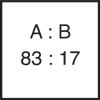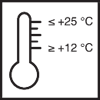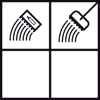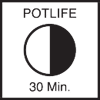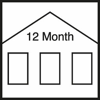Article No. 681626
Pigmented, conductive textured coating
Product specifications
Component A
Component B
Mixture
* Fire test class in defined systems (see test report on fire classification: Remmers conductive systems)
The stated values represent typical product characteristics and are not to be construed as binding product specifications.
Field of application
- Textured coating
Properties
- Slip-resistant
- Conductive
- Can be subjected to mechanical loads
- Can be subjected to chemical loads
- Coating compatibility test
- Physiologically harmless once fully cured
-
Preparation
-
Substrate requirements
The substrate must be firm, dimensionally stable, capable of bearing loads and free of loose constituents, dust, oil, grease, rubber marks and other substances that could interfere with adhesion.
The adhesive pull strength of the surface after priming must be at least 1.5 N/mm² on average (smallest single value min. 1.0 N/mm²), compressive strength at least 25 N/mm².
Suitable Remmers epoxy primers, epoxy scratch coats or epoxy mortars must always be used.
-
Preparations
Before the application of the product a smooth surface must be produced, e.g. with a scratch coat.
Epoxy Conductive must be applied according to the current Technical Data Sheet as transverse conducting layer.
Refer to the current Technical Data Sheet for detailed information on the single products.
-
-
Preparation
-
Combination container
Add the entire quantity of the hardener (component B) to the base compound (component A).
Pour the mixture into a separate container and mix again thoroughly.
Mix for at least 3 minutes.
Mix thoroughly with a slow-speed electric mixer
(approx. 300 - 400 rpm).Insufficient mixing is indicated by streaks forming.
-
Application
-
As a general principle, higher temperatures will reduce and lower temperatures will increase the times stated.
-
Working tools / cleaning
-
Notched trowel, notched scraper, suitable textured roller, suitable mixer
-
More detailed information can be found in the Remmers Tool Programme.
Clean tools, equipment and splashed material immediately while fresh with V 101.
Take suitable protective and waste disposal measures when cleaning.
-
Storage / shelf life
-
If stored unopened in the original container and kept cool, dry and protected from frost, min. 12 months (component A)/min. 24 months (component B).
-
Usage
-
Approx. 0.5 - 0.6 kg/m² binder
-
-
Application examples
-
Textured coating
The material should be applied evenly using a notched trowel or, for vertical application, a notched scraper (fitted with Remmers notched strip no. 22).
Uneven application can lead to visible texture differences and roller marks.
After applying, intensively re-roll the fresh material with a textured roller at right angles to the direction of application. To reduce roller marks etc., re-roll in one direction without pressure using a 50 cm textured roller, for example.
approx. 0.5 - 0.6 kg/m² binder
-
-
General information
-
Unless otherwise specified, all of the values and application rates given above have been determined under laboratory conditions (20 °C) using standard colours. Slight deviations from these values may arise if the product is worked with on site.
When coating continuous surfaces, only use materials with the same batch number as slight differences in colour, gloss and texture may occur.
Take the black colour of the transverse conducting layer into consideration when selecting the colour of the subsequent coating.
Before the application of the covering layer, the correct functioning of the transverse conducting layer and of the connections must be proved and registered in a measurement report.
Low levels of air humidity can cause a higher discharge resistance, uneven or thicker layers can even lead the coating to not be conductive at all.
The resulting surface texture is strongly influenced by the conditions on site and the application method. Therefore, surface texture is not covered by product liability.
Low thickness and low temperature can affect the visual effect of the finished surface.
Depending on the application and system, pores may be created due to air pockets when texturing the thixotropic coating material. These may accumulate dirt during use.
Abrasive mechanical loads leave traces of wear.
Suitable for vehicle traffic with rubber tyres; not suitable for vehicle loads with metal or polyamide tyres nor for dynamic point loads.
Low levels of air humidity can cause a higher discharge resistance, uneven or thicker layers can even lead the coating to not be conductive at all.
Epoxy resins are generally not colourfast when exposed to UV light or weather.
In case of repairs on the surface or working up to existing surfaces, there will be a visible transition in appearance and texture.
Anti-slip floors naturally require more cleaning effort than smooth surfaces. Therefore, the use of cleaning machines with soft brushes is recommended.
Further notes on working, system construction and maintenance of the listed products can be found in the latest Technical Data Sheets and the Remmers system recommendations.
-
-
Disposal instructions
-
Larger quantities of leftover product should be disposed of in the original containers in accordance with the applicable regulations. Completely empty, clean containers should be recycled. Do not dispose of together with household waste. Do not allow to enter the sewage system. Do not empty into drains.
-
-
Safety / regulations
-
For professional users only!
For further information on the safety aspects of transporting, storing and handling the product and on disposal and environmental matters, please see the current Safety Data Sheet and the brochure entitled "Epoxy Resins in the Construction Industry and the Environment", issued by Deutsche Bauchemie e.V. (3rd edition 2022).
-


